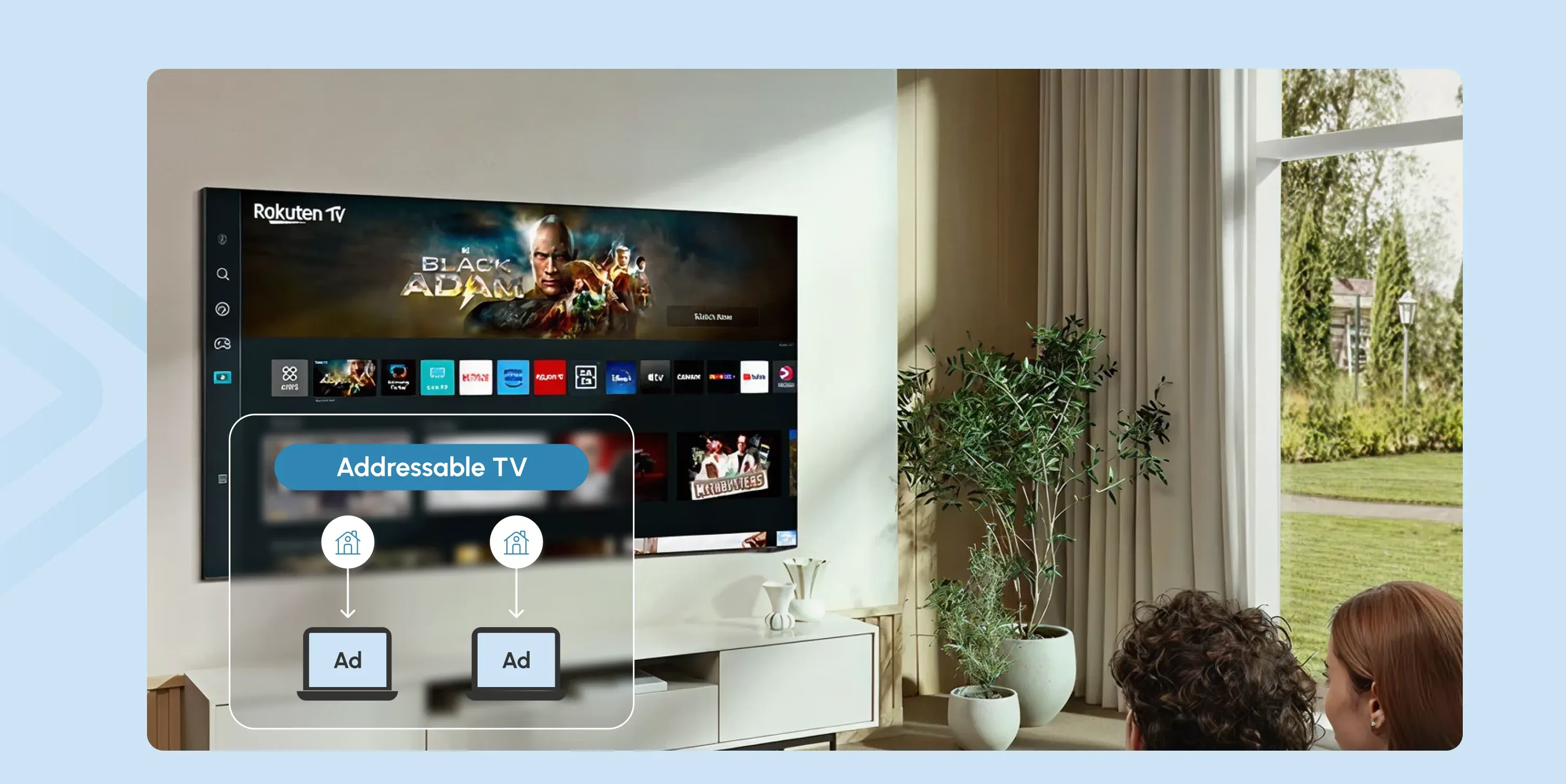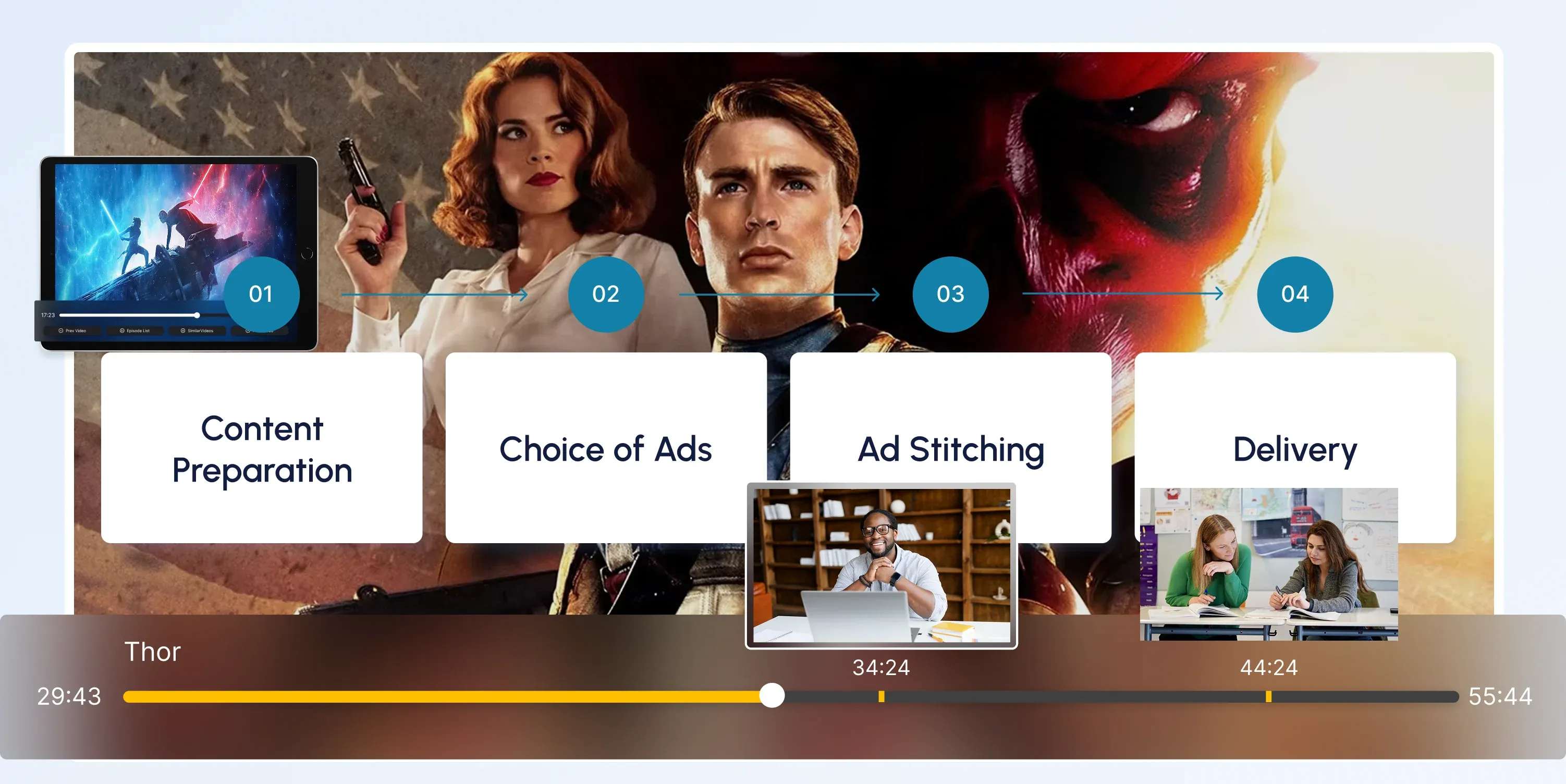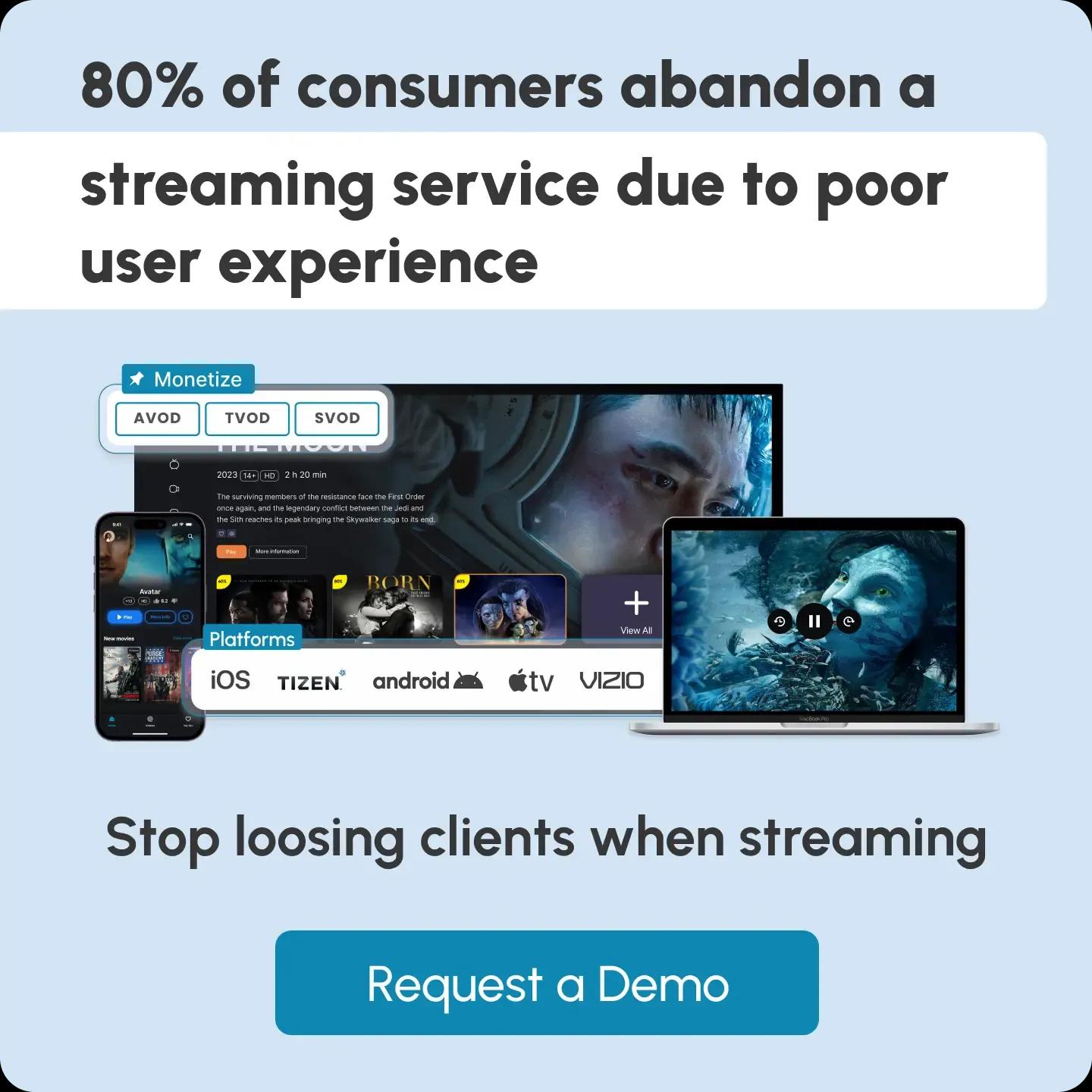Glossary term
Addressable Advertising

What Is Addressable Advertising?
Addressable advertising is a digital advertising approach that enables brands to deliver customized ads to specific households or individuals, even while they’re watching the same program or visiting the same platform.
Instead of serving the same generic ad to everyone, advertisers use audience data (such as demographics, interests, location, or past behavior) to “address” each viewer with a message that’s more relevant to them.
Example:
Imagine two households watching the same live sports event through a streaming service. The first household might see an ad for a minivan, while the second might see an ad for a sports car, because the platform has data indicating their different interests and preferences.
What are the Benefits of Addressable Advertising?
- Delivers ads to specific households or individuals based on data.
- Minimizes impressions on irrelevant audiences.
- Improves efficiency, resulting in a better return on ad spend.
- Tracks ad impact across TV, mobile, and digital channels.
- Tailors ads to match household interests and behaviors.
How Does Addressable Advertising Work?
Addressable advertising blends audience data, ad tech infrastructure, and delivery mechanisms to ensure the right ad reaches the right household and device. Here’s the technical flow:
Stage 1. Audience Data Collection
First, the system starts collecting data, then gradually matches targeted ads with the “addresses” it needs to send them to. This includes:
First-party data: Subscriber details, app usage, purchase history, loyalty programs.
Third-party data: Demographic overlays, geolocation, credit bureau info, purchase intent data.
Device graphing: The system uses “identity graphs” to match devices (mobile, smart TV, tablet) back to a household.
Stage 2. Segmentation and Targeting
Audiences are grouped into micro-segments (e.g., “SUV intenders in urban areas” or “millennial parents with kids under 5”). These segments can be combined with contextual triggers (like time of day, content genre, or weather).
Stage 3. Ad Decisioning
After collecting and organizing all the necessary data, the system waits for an available ad slot. When it becomes available (e.g., a CTV commercial break), a decisioning engine evaluates:
- The user’s profile
- Available campaigns that match the profile
- Budget, pacing, and frequency rules
Once the system clarifies everything, it “chooses” the most relevant ad.
Stage 4. Ad Delivery
Ad delivery is possible in two ways:
On digital or OTT, delivery happens at the device level via app SDKs, ad servers, or player APIs.
On linear TV, delivery can occur at the set-top box level: instead of one broadcast ad, each box splices in the targeted ad for its household.
Stage 5. Measurement and Feedback Loop
The process doesn’t end with ad delivery. Thanks to addressable advertising, metrics like impressions, completion rates, conversions, and even offline sales lift are visible and can come in handy. The data flows back, so advertisers get to optimize campaigns in near real time with higher personalization.
7 Core Technologies Behind Addressable Advertising
We explored the stages of how addressable advertising works. Now, let’s check out the main technologies that support every process involved in it.
1. Identity Resolution and Data Management
Addressable advertising relies on the ability to connect fragmented data points into actionable audience profiles. Three core technologies make this possible:
Data Management Platforms (DMPs)
These platforms aggregate, categorize, and activate large-scale audience data to support campaign targeting across digital ecosystems. It can include demographic, behavioral, and transactional signals.
Customer Data Platforms (CDPs)
CDPs merge first-party data from multiple sources (websites, mobile apps, CRM systems, offline records) into unified household or individual profiles for more precise and compliant targeting.
Identity Graphs
These link diverse identifiers (cookies, mobile advertising IDs (MAIDs), IP addresses, subscriber details, and logins) into a single, persistent “addressable” identity that can be recognized across devices and channels.
2. Ad Decisioning and Ad Servers
Ad Servers decide which ad to show in a given slot, based on audience targeting and campaign rules.
Example:
Google Ad Manager decides which ad to show by running a real-time auction that weighs bid price, audience match, relevance, and frequency caps, all powered by Google’s identity graph.
Ad Decisioning Engines integrate with audience data and bidding platforms to select the right ad in real time.
Example:
When a viewer in a CTV app reaches a commercial break, the engine determines whether to display a minivan ad (targeting family households) or a sports car ad (targeting single professional households).
3. Set-Top Box and Smart TV Middleware
On linear TV, addressability often happens at the set-top box (STB) level. It is a device that connects to a TV and receives signals from a cable, satellite, or internet provider, then converts them into content the TV can display. The set-top box uses subscriber data and stored creatives to swap ads locally.
So, even though the programming is identical nationwide, STBs make addressable advertising possible for linear TV.
4. Dynamic Ad Insertion (DAI) Systems
Dynamic Ad Insertion seamlessly integrates ads into video streams in real-time, delivering personalized advertising experiences to each viewer. It’s widely used in CTV, OTT platforms, and linear TV with set-top boxes to enable addressable advertising.
DAI can replace a generic ad with a household-targeted one, either with:
Client-side ad insertion (CSAI): Ad stitched in by the app or the player.
Server-side ad insertion (SSAI): An ad is stitched into the stream at the server level, making it seamless.
Learn more about DAI, SSAI, and CSAI.
5. Programmatic Advertising Infrastructure
If addressable advertising is about delivering specific ads to specific households, programmatic advertising is the technology and marketplace that makes this targeting possible at scale.
So programmatic advertising is the automated buying and selling of digital ad inventory through real-time systems, instead of manual negotiations. It uses software platforms like Demand-Side Platforms (DSPs) and Supply-Side Platforms (SSPs) to:
- Run real-time auctions for each ad impression.
- Decide which advertiser’s ad should be shown.
- Optimize campaigns using audience data, bidding strategies, and machine learning.
Demand-Side Platforms (DSPs) enable advertisers to purchase addressable inventory in real time, optimizing bids and targeting based on audience data.
Supply-Side Platforms (SSPs) allow publishers to manage and sell their inventory programmatically while applying audience segments to increase relevance and yield.
6. Measurement and Attribution Tech
These technologies track effectiveness and prove ROI at the household or individual level. It involves cross-device attribution and offline sales matchback.
Example:
A CTV ad campaign for a retail brand can be matched with loyalty card purchase data to see if exposure drove in-store sales.
7. Privacy and Compliance Technologies
These technologies stand for secure and safe processing. Privacy and compliance ensure that ad targeting respects regulations such as GDPR, CCPA, and HIPAA. They enforce consent management, anonymization, and secure data handling, allowing advertisers to personalize ads without breaching user trust or violating legal requirements.
Example:
A healthcare streaming service wants to run addressable ads for wellness products. To stay compliant with HIPAA, the platform uses a consent management system and anonymized identity resolution. This way, only users who have opted in see the ads, and sensitive health data is never exposed to advertisers.
Addressable vs Traditional Advertising
It’s crystal clear that addressable advertising holds a massive advantage over traditional: personalized and targeted ads. So, it’s a massive reach for brand awareness against precise household or individual targeting.
Which one excels?
Here is a comparison table to find out:
| Feature | Traditional TV Advertising | Addressable TV Advertising |
|---|---|---|
| Ad Delivery | The same ad is shown to all viewers watching a program | Different ads are delivered to different households, even during the same program |
| Targeting | Broad (by channel, program, daypart, demographics) | Precise (by household or individual data: demographics, behavior, purchase history) |
| Buying Model | Fixed upfront buys, limited flexibility | Data-driven, often programmatic, with more flexible buying |
| Measurement | Estimated ratings (e.g., Nielsen) | Household or individual-level attribution and ROI tracking |
| Personalization | None (one-size-fits-all messaging) | High (ads tailored to household interests or needs) |
| Reach vs. Precision | Maximizes reach but sacrifices precision | Smaller reach but exact targeting |
| Use Case Example | A national soda ad during the Super Bowl | One household sees a family SUV ad, while another sees a luxury sports car ad, during the same show |
Back in the day, traditional advertising covered every need an advertiser could have. Now the picture is different. Just a broad audience is not enough; advertisers want precision targeting, measurable ROI, and personalization at scale, which traditional TV cannot match.
As audiences fragment across OTT, CTV, and digital platforms, advertisers need the ability to reach the right households with relevant messages, not just broadcast to the masses. This is why the winner is addressable advertising.
Frequently Asked Questions
Content Writer
Anush Sargsyan is a content writer specializing in B2B content about OTT streaming technologies and digital media innovation. She creates informative, engaging content on video delivery, OTT monetization, and modern media technologies. The goal is to help readers easily understand complex ideas. Her writing is the bridge between technical detail and practical insight, making advanced concepts accessible for both industry professionals and general audiences.
Related terms

AVOD (Advertising-Based Video on Demand)
Explore how AVOD works, its monetization model, and why it's popular for free streaming platforms. Read the full definition on inorain.com glossary.

CSAI (Client-Side Ad Insertion)
Learn how CSAI delivers ads through the video player, enabling targeting, tracking, and monetization.

